The Complete Commercial Reach in Refrigeration Buyers Guide 2025
The Complete Commercial Reach-In Refrigeration Buyer's Guide 2025
Master reach-in cooler and freezer buying with real auction data from 3,114 sales. 67% tested working with documented temperatures. Compare True, Beverage-Air, Traulsen brands, understand inspection red flags, and leverage auction pricing that makes food safety compliance affordable.
The Temperature Line Between Success and Shutdown
"Grab some lemons out of the Delfield." "Pull the roast from the True and don't forget to restock the tea in the Bev-Air." These brand names have become so ubiquitous in commercial kitchens that staff use them like "Kleenex" or "Band-Aids"—generic terms for equipment that's simply always there, always running, always keeping food safe.
Until it isn't.
For most operators, refrigeration isn't a problem until it's a problem. And when it becomes a problem, it becomes a catastrophic one. More than any other equipment in the kitchen, refrigeration shortfalls are "worked around" with short-term marginal fixes. Transferring everything to the walk-in at end of service. Adding ice to reach-ins. Running units on colder settings to compensate. These aren't solutions—they're symptoms of equipment that needs replacing.
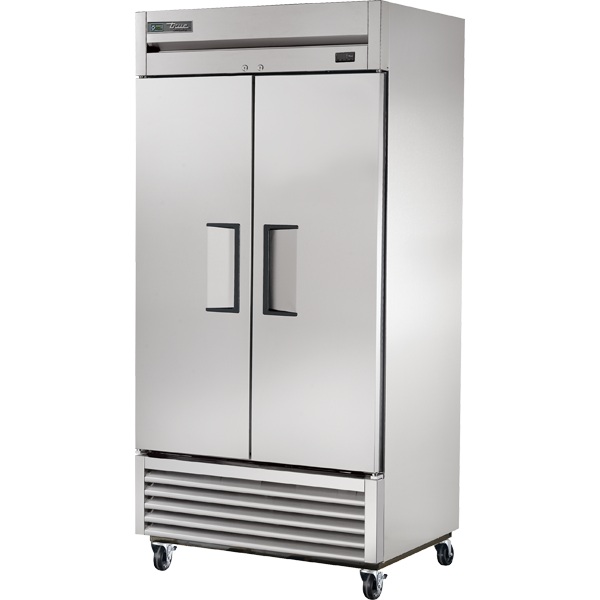
True T-35-HC brand new in box—the industry standard that kitchen staff reference by name regardless of actual brand installed
The mentality, unfortunately, is that malfunctioning refrigeration is prohibitively expensive to replace. Looking at auction prices, we can demonstrate this is simply not true. We receive more refrigeration than any other type of equipment. Why? Because it's used everywhere—every restaurant, every café, every convenience store, every commercial kitchen. Yes, some units arrive non-functional. But most work perfectly. And even with functionality considered, replacement units temping correctly are much better, safer, and more usable than storing potato salad at 57 degrees.
Particularly when the health inspector comes around.
The cost of a working refrigerator at auction is far less than the cost of an inspection report stating: "The person in charge of this facility is not exercising sufficient food safety controls as evidenced by this non-compliant inspection." That statement can end businesses. A $400 working reach-in from auction prevents it.
The fact is, many operators don't know about secondary market equipment auctions. They consider new equipment dealers and wholesalers, or used equipment with dubious functionality, to be their only choices. But here we are auctioning 2,000+ pieces of working reach-in refrigeration yearly at significant discounts. Our analysis of 3,114 reach-in cooler and freezer sales over 12 months reveals pricing patterns, brand performance data, and inspection intelligence unavailable elsewhere.
Market Reality: 3,114 Sales Analyzed
- Total sales: 3,114 reach-in coolers and freezers over 12 months
- Tested and Working: 2,086 units (67.0%)
- Does Not Get Cold: 528 units (17.0%)
- Not Tested/Unknown: 500 units (16.1%)
The Transparency Advantage: Unlike dishwashers, ranges, or combi ovens that cannot be tested during preview, most reach-ins operate on standard 115V power. We plug them in, verify temperature with IR thermometers, and document results. You know what you're bidding on.
This 67% working rate represents testable transparency no other equipment category offers. When a listing says "Tested and Working," we've verified the unit holds 40°F or below for coolers, 0°F or below for freezers, and confirmed the thermostat cycles properly to maintain temperature. When a listing says "Does Not Get Cold," we've given the unit minimum 45 minutes to attempt cooling and documented the failure.
The Working Premium: Real Numbers
| Condition | Units | Median Price | Price Range |
|---|---|---|---|
| Tested and Working | 2,086 | $310 | $0.26 - $4,650 |
| Does Not Get Cold | 528 | $51 | $0.01 - $2,350 |
| Not Tested/Unknown | 500 | $165 | $0.00 - $7,501 |
The 6X price difference between working units ($310 median) and non-working units ($51 median) demonstrates how the market values functionality certainty. Bidders pay substantial premiums to eliminate the "will it work?" question. This price gap also reveals the parts-tier opportunity: non-working units at $51 median contain valuable compressors, condensers, shelving, doors, and gaskets for operators maintaining existing equipment.
BNSD vs Used: Working Units Only
| Condition | Units | Median Price | Premium |
|---|---|---|---|
| Brand New Scratch & Dent (Working) | 432 | $700 | 2.3X |
| Used Working | 1,654 | $300 | Baseline |
The 2.3X BNSD premium ($700 vs $300) is modest compared to combi ovens (11.5X) or dishwashers (2.1X). This reflects the commodity nature of refrigeration—operators prioritize function over newness when the used market delivers reliable working units at substantial savings. BNSD refrigeration makes sense for operators prioritizing warranty-like confidence and latest features, but used working units deliver exceptional value for budget-conscious buyers.
Price Tier Distribution: Working Units
| Price Range | % of Working Sales | Typical Units |
|---|---|---|
| Under $100 | 8.0% | Older models, minor brands, cosmetic issues |
| $100-$250 | 26.8% | Value sweet spot, single-door units |
| $250-$500 | 28.7% | Quality 1-2 door units, major brands |
| $500-$750 | 15.0% | Premium 2-door, entry 3-door, freezers |
| $750-$1,000 | 8.6% | 3-door units, premium freezers |
| $1,000-$2,000 | 11.4% | BNSD units, large capacity, specialty |
| Over $2,000 | 1.6% | Premium BNSD, specialty configurations |
The sweet spot is clear: 55.5% of working units sell between $100-$500. This tier delivers functional commercial refrigeration at prices making food safety compliance genuinely affordable. Compare to new equipment pricing—a True 2-door reach-in cooler retails around $5,000-$6,000, a 2-door freezer approximately $7,000. Auction working units at $300-$500 represent 90%+ savings.
Understanding Reach-In Types
Door Count and Capacity
Stand-up reach-in units are sized by door count: single, double, and triple. Capacity scales accordingly—more doors mean more interior cubic footage for product storage. The pricing reflects this progression:
| Configuration | Working Units | Median Price | Price Range |
|---|---|---|---|
| Single Door (1-Door) | 1,080 (52%) | $299 | $0.26 - $3,315 |
| Double Door (2-Door) | 762 (37%) | $425 | $26 - $4,650 |
| Triple Door (3-Door) | 149 (7%) | $1,000 | $56 - $4,000 |
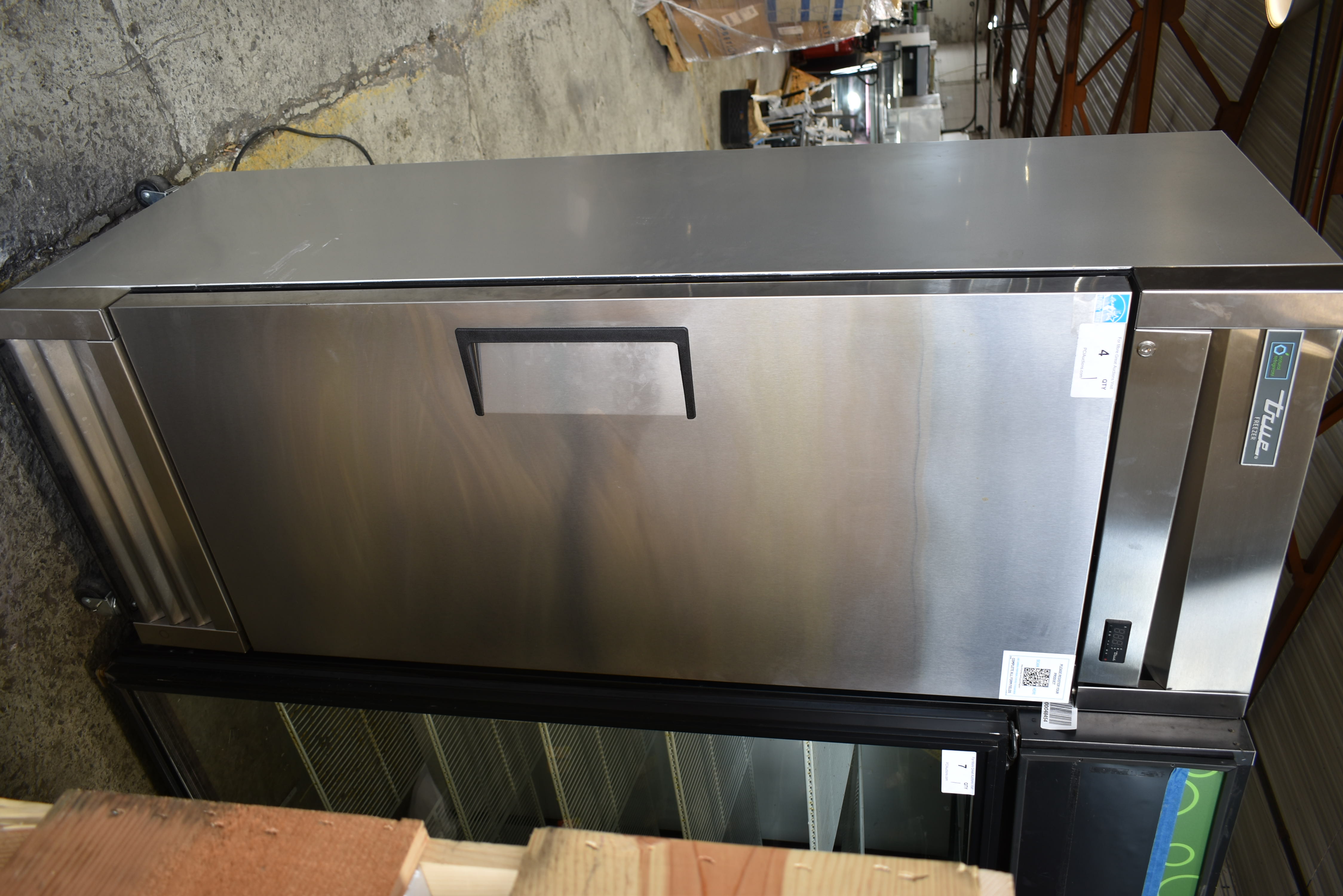
True T-19F-HC single door freezer—the compact workhorse for smaller operations or supplemental capacity
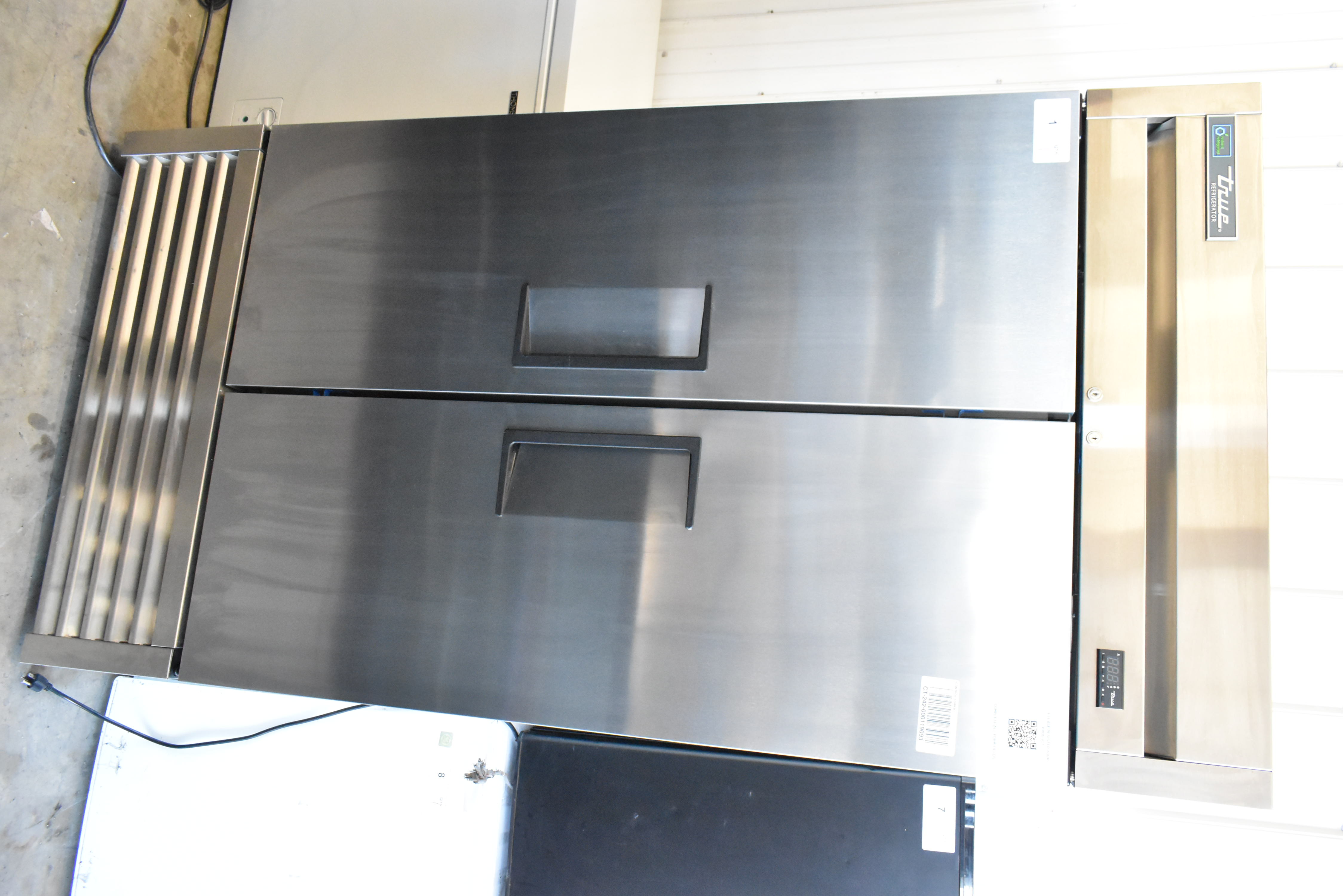
True T-35-HC 2-door cooler—the most common configuration for full-service restaurant applications
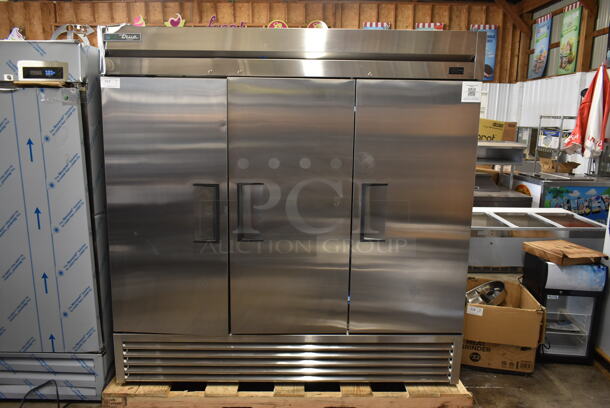
True T-72F-HC 3-door freezer—high-capacity storage commanding $1,000+ median auction pricing
Some units feature subdivided compartments within standard door configurations. A single-door sized unit may have 2 half-doors with separate compartments. Double-door sizes can feature 4 half-doors, triple-door sizes 6 half-doors. This subdivision provides organizational flexibility without changing overall footprint.
Coolers vs Freezers
| Type | Working Units | Median Price | Temperature Standard |
|---|---|---|---|
| Coolers (Refrigerators) | 1,638 | $300 | 40°F or below |
| Freezers | 417 | $656 | 0°F or below |
Freezers command 2.2X premium over coolers ($656 vs $300 median). The additional compressor capacity, insulation thickness, and engineering complexity required to achieve and maintain 0°F temperatures drives higher new pricing and corresponding auction values. Freezers also experience more mechanical stress—the temperature differential between ambient conditions and target temperature is substantially greater than coolers.
Glass Door Merchandisers vs Solid Door Units
| Type | Working Units | Median Price | Primary Application |
|---|---|---|---|
| Glass Door (Merchandisers) | 1,340 | $283 | Retail display, beverages, grab-and-go |
| Solid Door (Stainless) | 645 | $576 | Back-of-house, kitchen production |

True GDM-49F glass door merchandiser—designed for retail display where customers select products directly
Glass door refrigerators and freezers are called merchandisers because they're designed for retail display. Customers can see products and make selections without opening doors. Beverage coolers, convenience store grab-and-go cases, and ice cream freezers use this configuration.
In commercial back-of-house environments, glass becomes a liability. One wrong move during service—a pan swung too fast, a door bumped with a loaded sheet tray—creates significant problems. Solid stainless steel doors provide better insulation, greater durability, and appropriate functionality for production kitchen environments where visibility isn't needed.
The 2X solid door premium ($576 vs $283) reflects this durability advantage and the higher new pricing for commercial-grade stainless construction versus merchandiser-focused glass door units.
Dual Temperature Zone Units
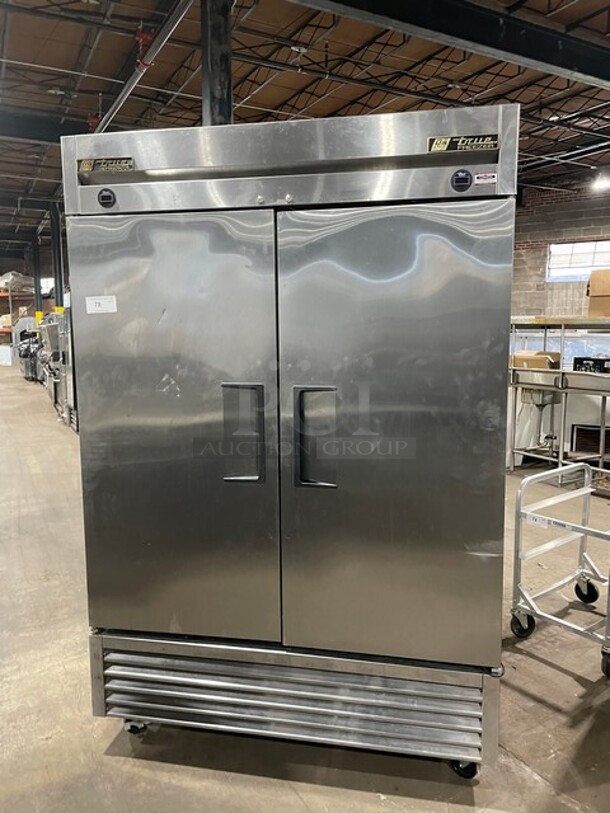
True dual-temperature reach-in—refrigerator and freezer compartments in a single footprint for space-constrained applications
Some reach-ins feature dual temperature zones allowing refrigerator and freezer compartments in a single unit. These are uncommon but not rare, serving as space savers for operations needing both frozen and refrigerated storage in limited footprints. Common application: service refrigerators where items need keeping frozen and refrigerated but not in huge volumes—fries frozen and chicken cutlets refrigerated for the fryer line, for example.
Dual-zone units typically have two separate refrigeration systems and may require two electrical outlets. Testing verifies both sides achieve proper temperatures—on occasion, one side works while the other doesn't. Pricing generally aligns with freezer equivalents given the complexity involved.
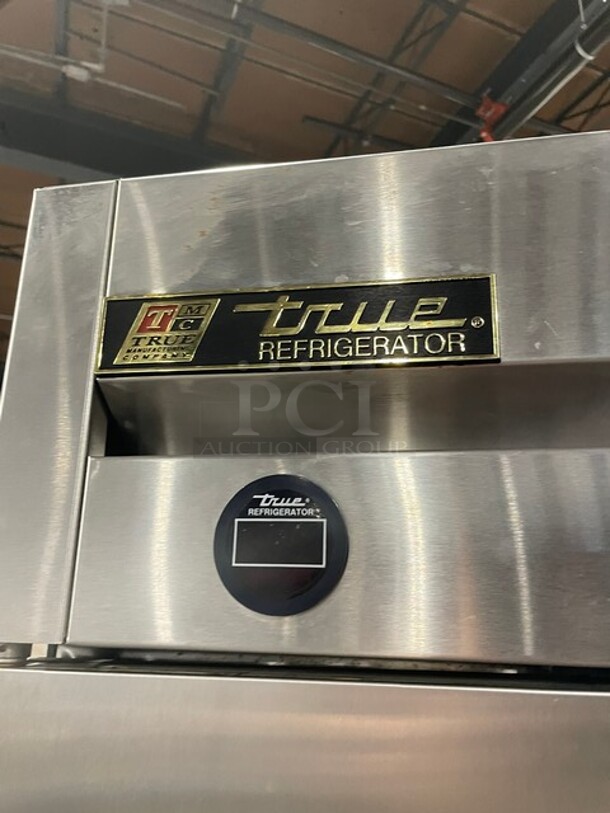
External thermostat controls—dual-zone units require independent temperature management for each compartment
Compressor Location: Top Mount vs Bottom Mount
Commercial reach-ins position refrigeration components (compressor and condenser) either below the cabinet or on top. This distinction affects performance, maintenance, and suitability for specific environments.
Bottom Mount Compressors
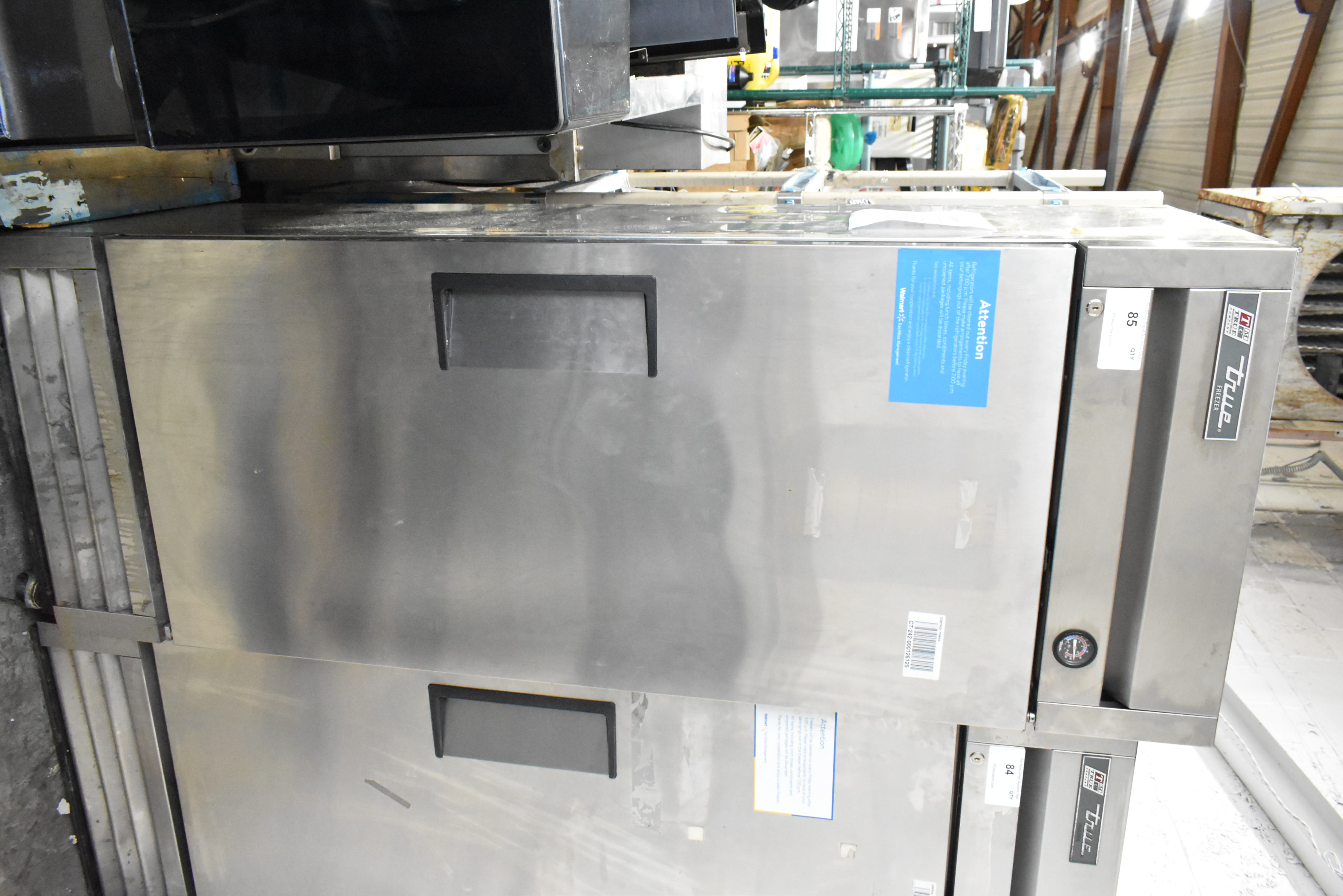
Bottom mount configuration—compressor and condenser located below the cabinet for hot kitchen efficiency
Bottom mount designs position the refrigeration system near floor level where ambient air tends to be coolest, particularly in hot kitchen environments. Heat rises, so floor-level air provides more efficient cooling for condenser coils. This keeps the compressor running more efficiently, potentially extending equipment lifespan.
Cleaning the condenser coil and fan is also easier with bottom mount configurations—accessible from the front without reaching overhead. Regular condenser cleaning is essential maintenance (weekly recommended), so accessibility matters for operational compliance.
Top Mount Compressors

Top mount configuration—compressor on top keeps the system away from floor-level debris accumulation
Top mount designs address a different concern: floor-level debris. In bakeries, pizza shops, or any environment where flour, corn starch, and powdery substances accumulate at floor level, having the condenser fan and compressor on top keeps the system from getting clogged with particulate. Clean condenser coils maintain efficient refrigeration—when coils become fouled, the system works harder to maintain temperatures, consuming more energy and accelerating wear.
Top mount configurations also provide slightly more interior storage space (no compressor housing at bottom) and somewhat lower shelf heights for easier access to upper storage.
The Environment Decision
Neither configuration is inherently superior. Bottom mount excels in hot kitchens with clean floors. Top mount excels in environments with significant floor-level particulate. Both work in nearly all applications with appropriate planning and maintenance. The key is matching configuration to your specific environment and committing to regular condenser cleaning regardless of position.
Remote Compressor Systems
Some larger units (typically 3-door or bigger) feature remote compressor systems similar to walk-in coolers. Only the evaporator unit sits inside the refrigerator/freezer cabinet. The compressor and condenser are mounted elsewhere—often outside the kitchen or in a mechanical room—connected via copper refrigerant lines.
Remote systems operate more efficiently because the condenser isn't fighting kitchen heat. But the installation complexity creates significant drawbacks: copper line runs must be properly sized and charged, the remote location requires planning and access, and servicing becomes more complicated.
Remote units appear at auction infrequently because they typically stay put when installed. Like walk-ins, they're semi-permanent installations rather than moveable equipment. When available, they suit operators with existing remote infrastructure or those planning new construction where remote mounting makes sense.
The Brand Hierarchy: True Dominates Everything
True Manufacturing commands the reach-in refrigeration market at auction with 985 working units—47% of all working sales. Nearly half of every working reach-in sold is a True. This dominance reflects decades of industry standard-setting, robust construction, and parts availability that makes True the default specification for commercial kitchens.
- Working units sold: 985 (47% of all working units)
- Median price: $400
- Price range: $0.26 - $4,000
- BNSD True units: 68 at $1,000 median
When kitchen staff say "grab it from the True," they mean reach-in refrigeration regardless of actual brand installed. This Kleenex-effect reflects True's market dominance and industry-standard status.
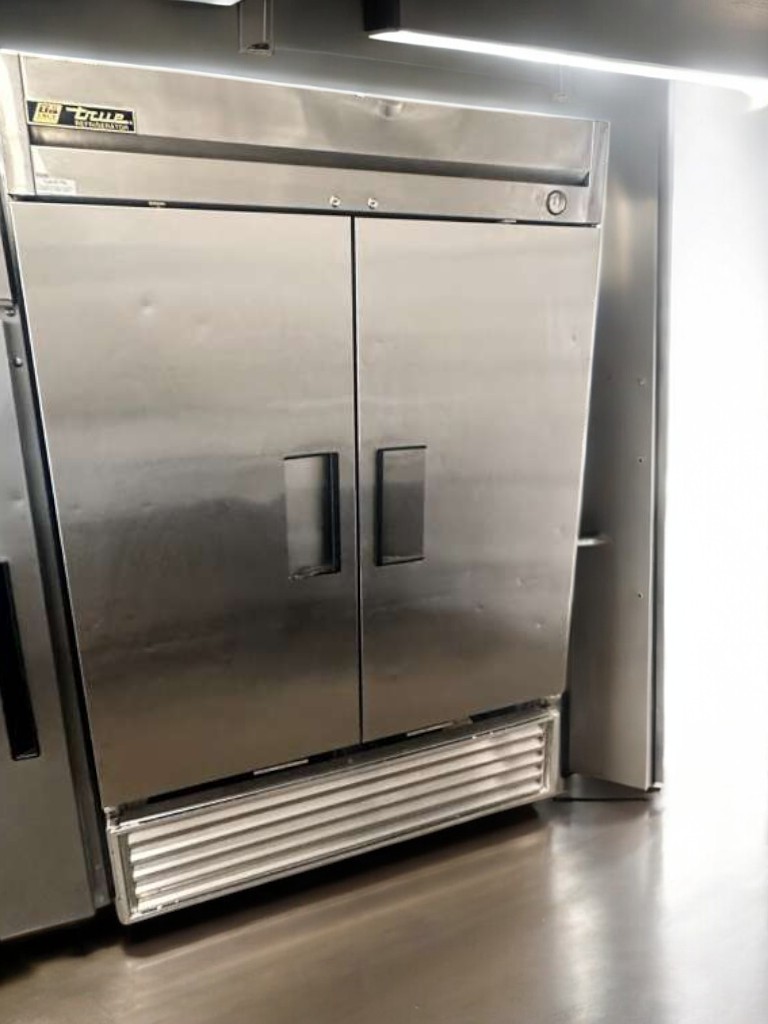
True T-49—the classic 2-door configuration that's become the industry standard specification
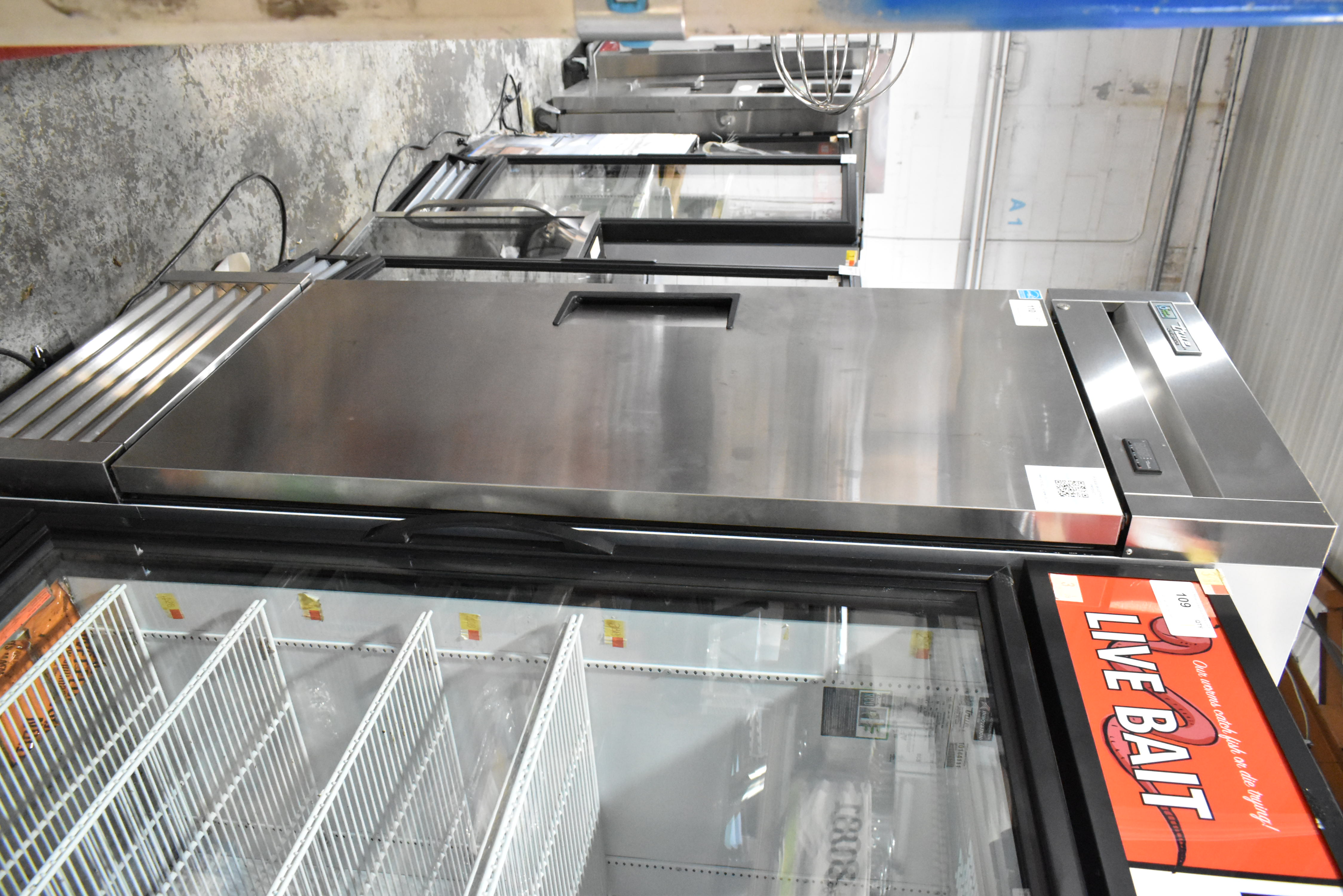
True T-23 single door—compact workhorse found in nearly every commercial kitchen application
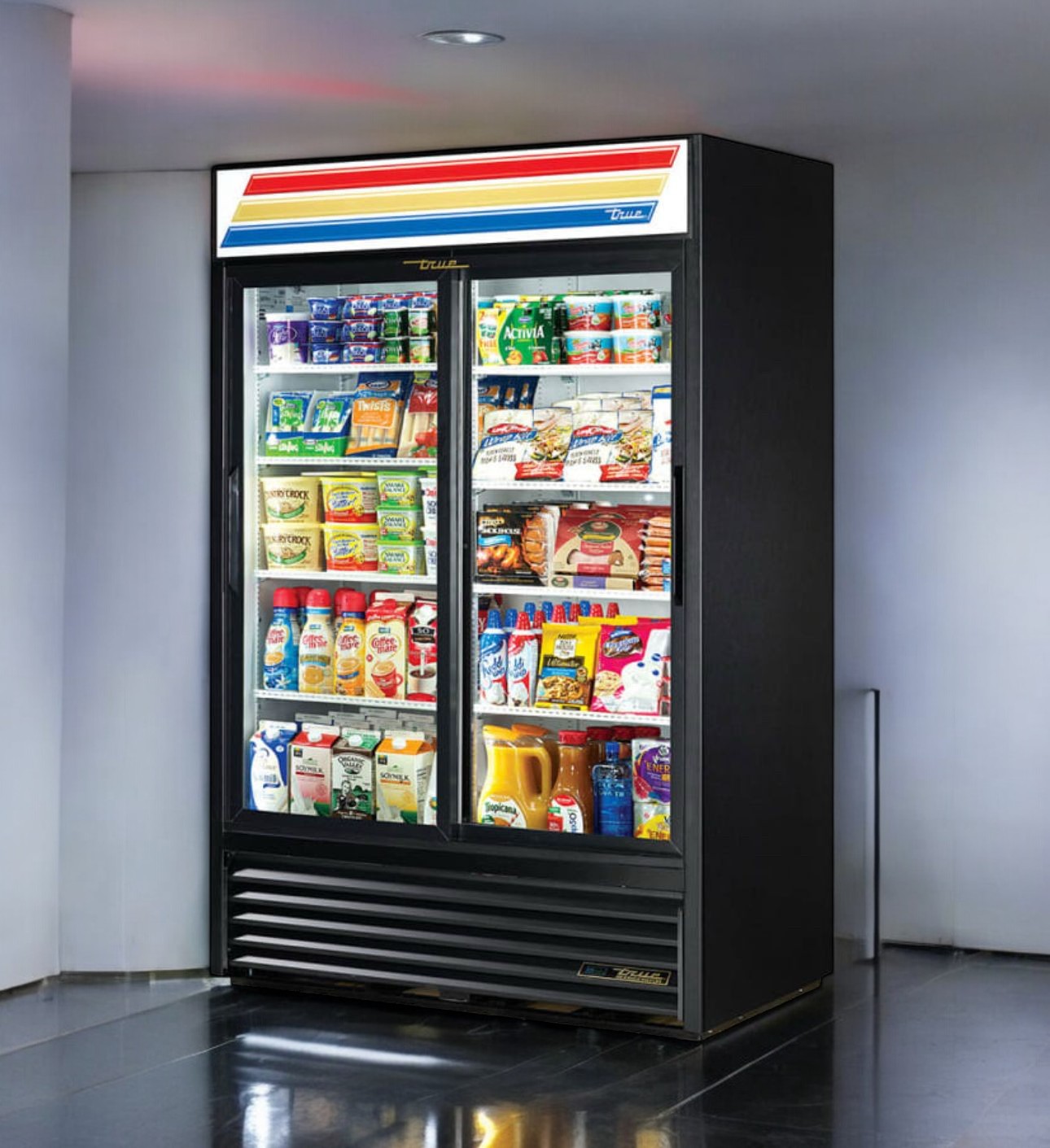
True GDM-45 merchandiser—the glass door retail display standard for grab-and-go applications
Complete Brand Performance Hierarchy
| Brand | Working Units | Median Price | Price Range |
|---|---|---|---|
| Migali | 73 | $875 | $51 - $2,200 |
| Avantco | 147 | $675 | $0.51 - $3,200 |
| Hoshizaki | 10 | $600 | $260 - $1,275 |
| Beverage-Air | 45 | $600 | $51 - $3,355 |
| Delfield | 10 | $475 | $101 - $950 |
| Atosa | 19 | $405 | $100 - $2,306 |
| True | 985 | $400 | $0.26 - $4,000 |
| Turbo Air | 19 | $400 | $51 - $3,510 |
| Traulsen | 57 | $400 | $26 - $4,650 |
| Continental | 15 | $400 | $31 - $1,550 |
| Habco | 235 | $275 | $21 - $625 |
| Imbera | 35 | $115 | $21 - $550 |
Beverage-Air: The Reliable Alternative
Beverage-Air (often written Bev-Air in kitchen shorthand) represents the primary True alternative. Staff commonly say "check the Bev-Air" the same way they reference True—brand as generic noun. At $600 median, Beverage-Air commands premium pricing reflecting quality construction and industry acceptance. The brand serves operators wanting True-equivalent performance with potential cost savings or availability advantages.
Traulsen: Premium Commercial Grade
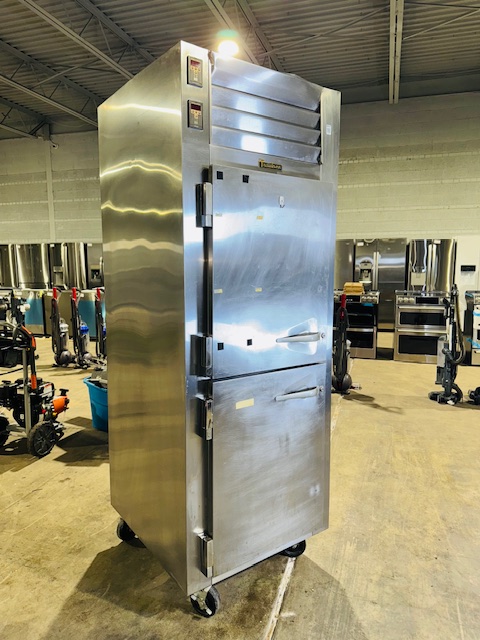
Traulsen RDT132WUT-HHS—premium construction with split compartment dual-temperature capability
Traulsen occupies the premium commercial tier with robust construction meeting demanding institutional applications. The $400 median at auction understates the brand's new pricing—Traulsen units often retail significantly higher than True equivalents. Auction Traulsen units represent exceptional value for operators seeking premium-grade equipment.
Habco and Imbera: The Volume Value Tiers
Habco (235 working units) and Imbera (35 units) occupy the value tier with $275 and $115 medians respectively. These brands serve operators prioritizing budget over brand prestige. The equipment functions—it cools to proper temperatures and maintains food safety—but may lack the construction robustness or parts availability of premium brands. For budget-constrained operations, these brands deliver functional refrigeration at accessible prices.
The Brand Decision Framework
True, Beverage-Air, Traulsen, and Delfield represent proven commercial-grade construction with excellent parts availability and service network coverage. These brands justify premium pricing through longevity and serviceability. Habco, Imbera, and similar brands work for budget-conscious operators accepting potentially shorter service lives and limited parts availability.
The kitchen shorthand test: if staff naturally refer to equipment by brand name ("grab it from the True"), that brand has earned industry-standard status. True and Beverage-Air pass this test universally.
Critical Inspection Points
Unlike combi ovens or dishwashers where visual inspection is the primary evaluation tool, reach-in refrigeration benefits from our electrical testing capability. Most units operate on standard 115V power, enabling powered evaluation before auction. However, visual inspection still matters—certain red flags indicate problems that even "working" status doesn't address.
The Piercing Valve: Major Red Flag

Piercing valve on refrigerant line—a major warning sign indicating questionable repair attempts
Piercing valves are small metal units with a cap and valve that fit over copper refrigerant lines, typically near the compressor. Some operators try to add more refrigerant to underperforming units by installing piercing valves and injecting additional refrigerant. This approach has fundamental problems.
The only time seeing a piercing valve is acceptable: if the technician just installed it in front of you. Otherwise, it signals shoddy repair attempts. Professional HVAC technicians use piercing valves only for diagnostics on Type 1 systems with less than 5 pounds of refrigerant and no service port. Once service is completed, a permanent access valve gets brazed onto the line, replacing the piercing valve.
Finding a piercing valve during inspection means someone attempted a shortcut repair. The unit may currently be cooling (explaining "Tested and Working" status), but the underlying leak likely persists. Budget for professional repair or view the unit as having a reduced service life expectancy.
Evaporator Fan Operation
The evaporator fan circulates cold air throughout the cabinet. Even if the refrigerant system is cooling properly, a non-functional evaporator fan severely limits circulation. Cold air pools at the bottom of the cabinet while upper shelves remain warmer. This creates temperature inconsistency that can push upper-shelf products into unsafe ranges.
During inspection or after purchase, verify the evaporator fan turns when the unit is running. Listen for fan operation—you should hear air movement from inside the cabinet. Non-functional fans are typically repairable (motor replacement), but the issue needs addressing before putting the unit into service.
Compressor Capacitor Issues
When a unit does not power on during testing, the root cause is frequently a detached or missing compressor capacitor. Capacitors step up voltage from the power supply to the working voltage of the compressor. They're relatively inexpensive components ($20-$50 typically) and replacement is straightforward for those with basic electrical knowledge.
If a unit powers on but the compressor doesn't engage (you hear nothing, or you hear a hum without the compressor actually running), suspect capacitor failure. This is one of the most economical repairs possible—a $30 part can restore functionality to an otherwise non-working unit purchased at parts-tier pricing.
Condenser Coil Condition

Clean condenser coils—proper maintenance keeps the refrigeration system running efficiently
Check the condenser fins during inspection. If the condenser looks like a carpet—heavily clogged with dust, grease, and debris—the previous operator provided lackluster maintenance. Fouled condensers force the compressor and condenser fan to work harder achieving the same cooling, accelerating wear and potentially shortening equipment lifespan.
Dirty condensers aren't deal-breakers—cleaning is straightforward with compressed air or a coil cleaning brush. But heavy accumulation signals overall maintenance neglect. If the operator didn't clean condensers, what else did they skip? Factor this into bidding calculations.
Door Gasket Integrity

Door gasket condition affects sealing and efficiency—check for tears, compression, and proper contact
Door gaskets create the seal preventing cold air escape when doors close. Worn, torn, or compressed gaskets allow cold air to leak continuously, forcing the compressor to run longer and harder maintaining temperature. Inspect gaskets for visible damage, compression (gaskets should be resilient, not permanently flattened), and proper contact around the entire door frame.
Gasket replacement is feasible—parts are available for major brands and installation is DIY-possible. But factor replacement cost into bidding if gaskets show wear. A $50-$100 gasket set plus installation time adds to total acquisition cost.
Interior Condition and Shelving

Interior with poly-coated wire shelving—check for rust, damage, and completeness of rack inventory
Examine interior surfaces for rust, staining, or damage. Check that shelving is present and in serviceable condition. Missing or damaged shelves need replacement—poly-coated wire racks are available but add cost. Rust on interior surfaces suggests moisture problems or extended periods without proper cleaning.
Specification Plate Verification
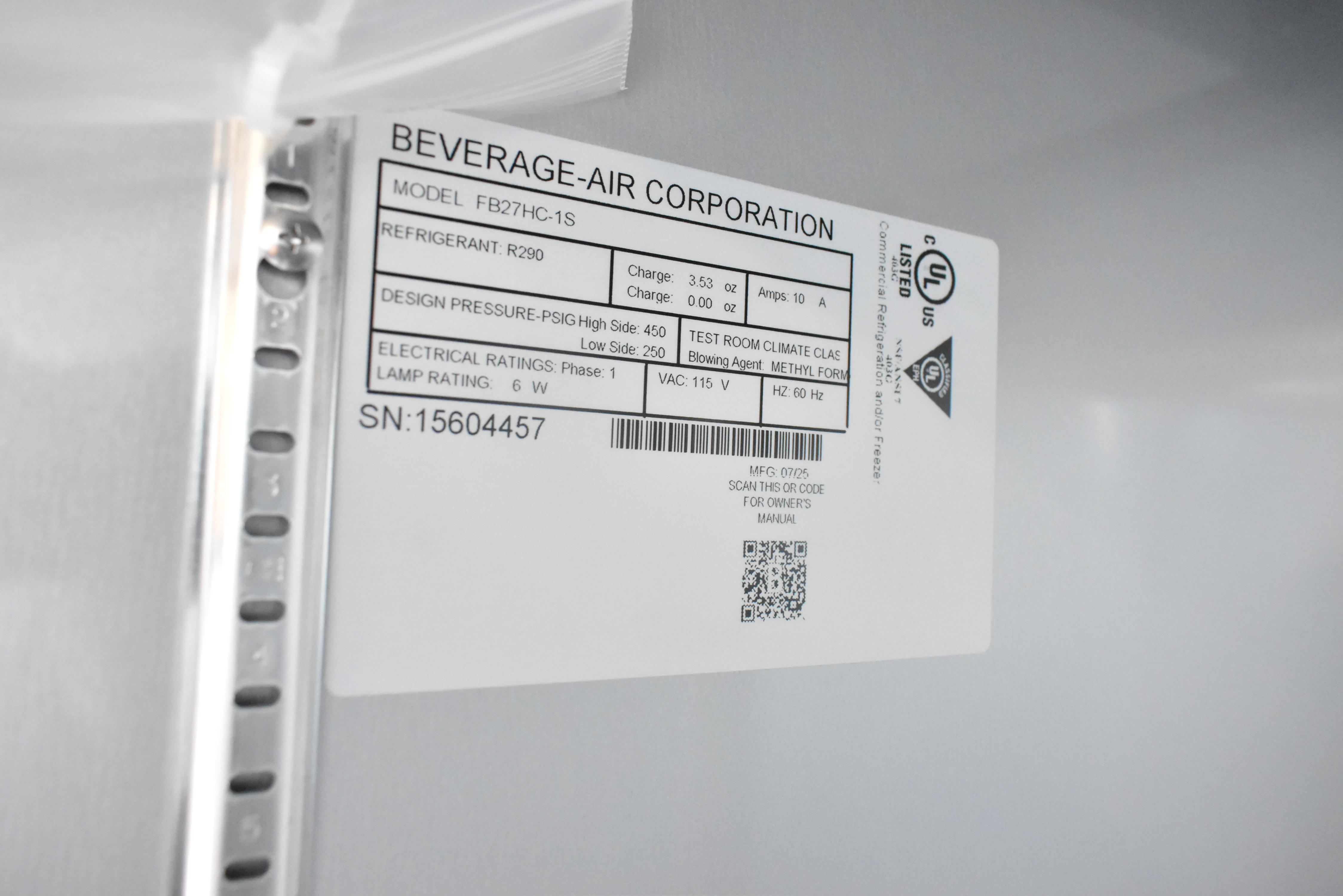
Specification plate detailing model, voltage, and phase requirements—verify compatibility before bidding
Every reach-in has a specification plate listing model number, voltage requirements, phase, and manufacturing information. Most units operate on 115V single-phase (standard outlet), but some larger units—particularly freezers—may require 208-230V service. Verify electrical compatibility with your facility before bidding.
The Health Inspector Reality
Let's talk about what actually happens when food safety fails. This isn't theoretical—these are real consequences that end businesses.
- Everything in the malfunctioning unit must be discarded—no exceptions
- Immediate and significant impact on inspection score
- Inspector enters comprehensive mode—every piece of temperature-controlled equipment gets thorough examination
- Subsequent inspections become far more rigorous
- Published inspection report damages reputation with anyone who reads it
Proper HACCP plans help. Regular temperature logging of refrigeration, wells, and potential failure points catches issues before they impact production. But for every one establishment diligently temping refrigeration, there are five that are not. And the ones that aren't are gambling with their business.
A Chef's Cautionary Tale
One of the things about chefs—we trade stories after the day is over. Frequently over drinks at whoever's location has a bar. One evening a chef/owner came in despondent. Inconsolable. Why? Their entire walk-in cooler was at 54 degrees.
They insisted the cooler was fine that morning when they temped it. Problem was, every line on the temperature log showed the same reading, with the same pen, and the same handwriting. It was obvious the sheet was hurriedly filled out before the inspection. The inspector couldn't prove falsification, but they damn sure knew it—and switched into hard-ass mode.
Everything was checked. And rechecked. Violations accumulated—some minor, some (like the cooler) major. It did not help matters that the owner argued the entire time. They claimed they were being reasonable, but their line cooks told the actual tale later. After refusing to discard the contents of the walk-in (likely thousands of dollars in product) and continuing to argue, the inspector called the police and shut them down.
They never fully recovered.
- Don't argue with the Board of Health or health inspector—you cannot win, and your business will suffer for attempting to
- A few thousand in discarded product hurts, but losing the business for want of compliance is worse
- If you have a HACCP plan, make sure it's actually done correctly—inspectors lose their sense of humor entirely when falsification becomes apparent
- Falsifying temperature logs is grounds for immediate employee termination because it can shut down operations
As an operator, the best approach when inspectors find issues: resolve them immediately and explain your action plan to prevent recurrence. A HACCP plan with actual temperature logs at set cadence during operation goes a long way toward demonstrating competence and commitment to food safety.
The Math That Matters
A working 2-door reach-in cooler at auction: $425 median. A True T-49 tested and working.
The contents of a malfunctioning reach-in that must be discarded during inspection: potentially thousands in product.
The damage to your inspection score and published report: immeasurable reputation harm.
The risk of shutdown and business failure: everything you've built.
The auction refrigerator wins this math equation every time. Working equipment that maintains proper temperature is insurance against catastrophic business loss. At $300-$500 for functional units, that insurance is remarkably affordable.
Our Testing Process: Transparency You Can Trust
Unlike dishwashers requiring hardwired connections or combi ovens needing water hookups, most reach-in refrigeration operates on standard 115V outlets. This enables comprehensive testing before auction listing.
How We Test
When equipment arrives, we plug in refrigeration first. While units begin cooling, we test equipment that doesn't require time—mixers, bread slicers, immersion blenders. This gives refrigeration ample time to reach operating temperature.
We temperature-check cabinets with IR thermometers. For coolers, if cabinet temperature holds at 40°F or below, it's marked "Tested and Working." For freezers, the threshold is 0°F or below. We verify the unit maintains temperature by allowing it to enter its holding cycle rather than actively cooling. This ensures the internal thermostat kicks the compressor back on as temperature rises, confirming the cycling system functions properly.
We generate test lists for each auction with temperature recording lines. Our documentation captures actual readings, not just pass/fail status.
What "Does Not Get Cold" Means
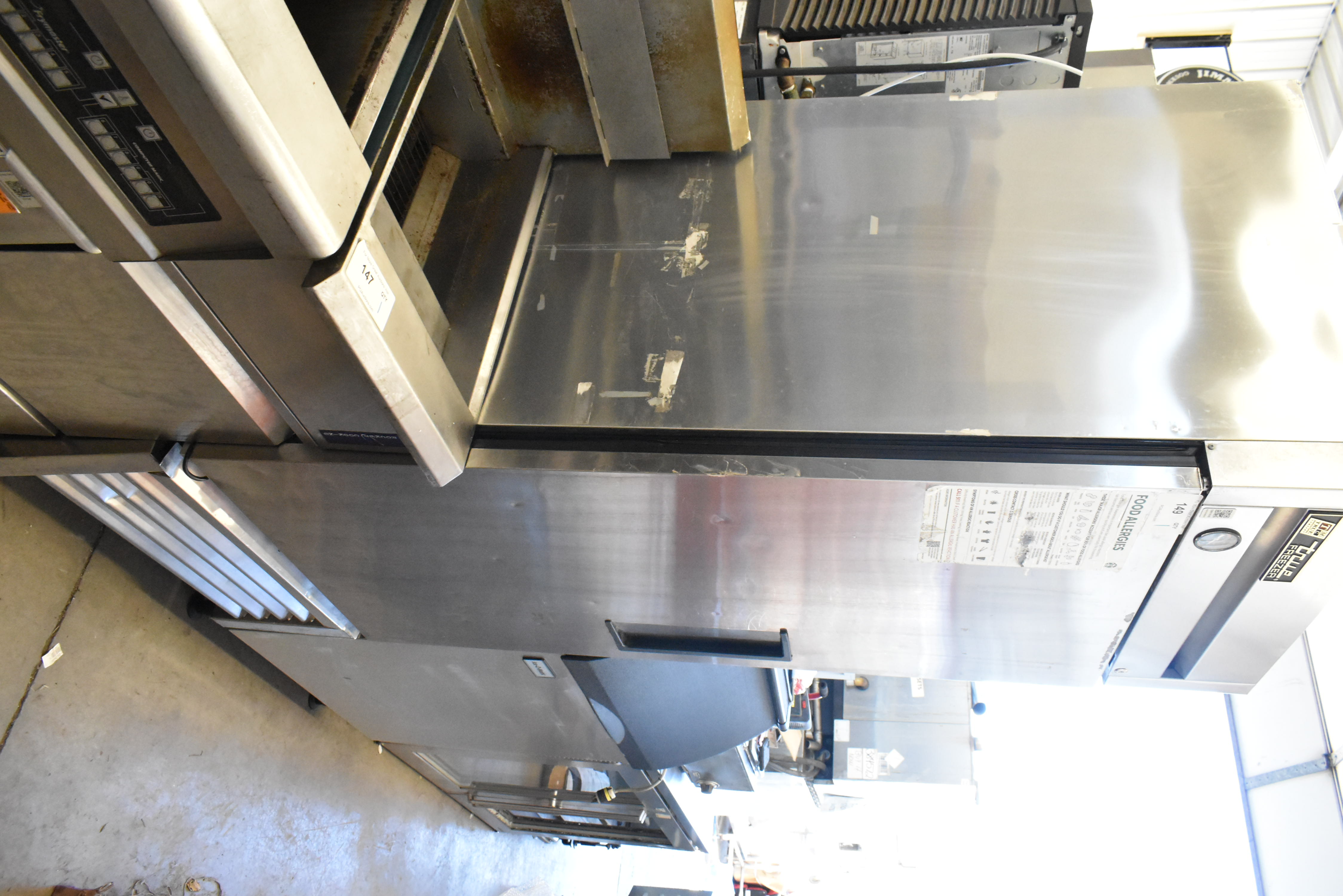
True T-23F listed as "Does Not Get Cold"—powered and tested for 45+ minutes without achieving target temperature
Units designated "Does Not Get Cold" have been running for minimum 45 minutes without achieving target temperatures. We give ample time for cooling to occur before declaring failure. This isn't a quick check—it's sustained testing identifying units with genuine refrigeration system problems.
These non-working units sell at substantial discounts ($51 median versus $310 for working units). They serve as parts sources for operators maintaining existing equipment, or as repair projects for those with HVAC capability. The 6X price difference between working and non-working reflects the market's accurate assessment of functionality value.
What "Cannot Test" Means
Some units cannot be tested—doors locked without keys, unusual electrical requirements (3-phase in a 1-phase facility), or damaged power cords preventing safe connection. These units sell in the "unknown" category ($165 median), priced between working and non-working to reflect uncertainty.
The transparency advantage is significant. When you see "Tested and Working" on a reach-in, you know we've verified temperature performance with documented readings. This eliminates the "will it work?" gamble that makes other equipment categories riskier at auction.
Installation and Maintenance
Commercial reach-in refrigeration offers installation simplicity that other equipment categories cannot match. Most units plug into standard 115V outlets and begin operating immediately. No gas lines, no water connections, no special electrical service required for the vast majority of units.
Installation Basics
- Electrical: Standard 115V single-phase for most coolers and many freezers. Some larger freezers require 208-230V service—verify specification plate before purchase.
- Level floor: Particularly important for units on casters. Unlevel positioning affects door seal and can cause condensate drainage issues.
- Airflow clearance: Allow adequate space around condenser for airflow. The cooler the ambient air around the condenser, the more efficiently the system operates. Avoid positioning with condenser against walls or in enclosed spaces without ventilation.
- Defrost water: Units handle defrost water with internal pans and evaporation coils. No external drainage required for standard installations.
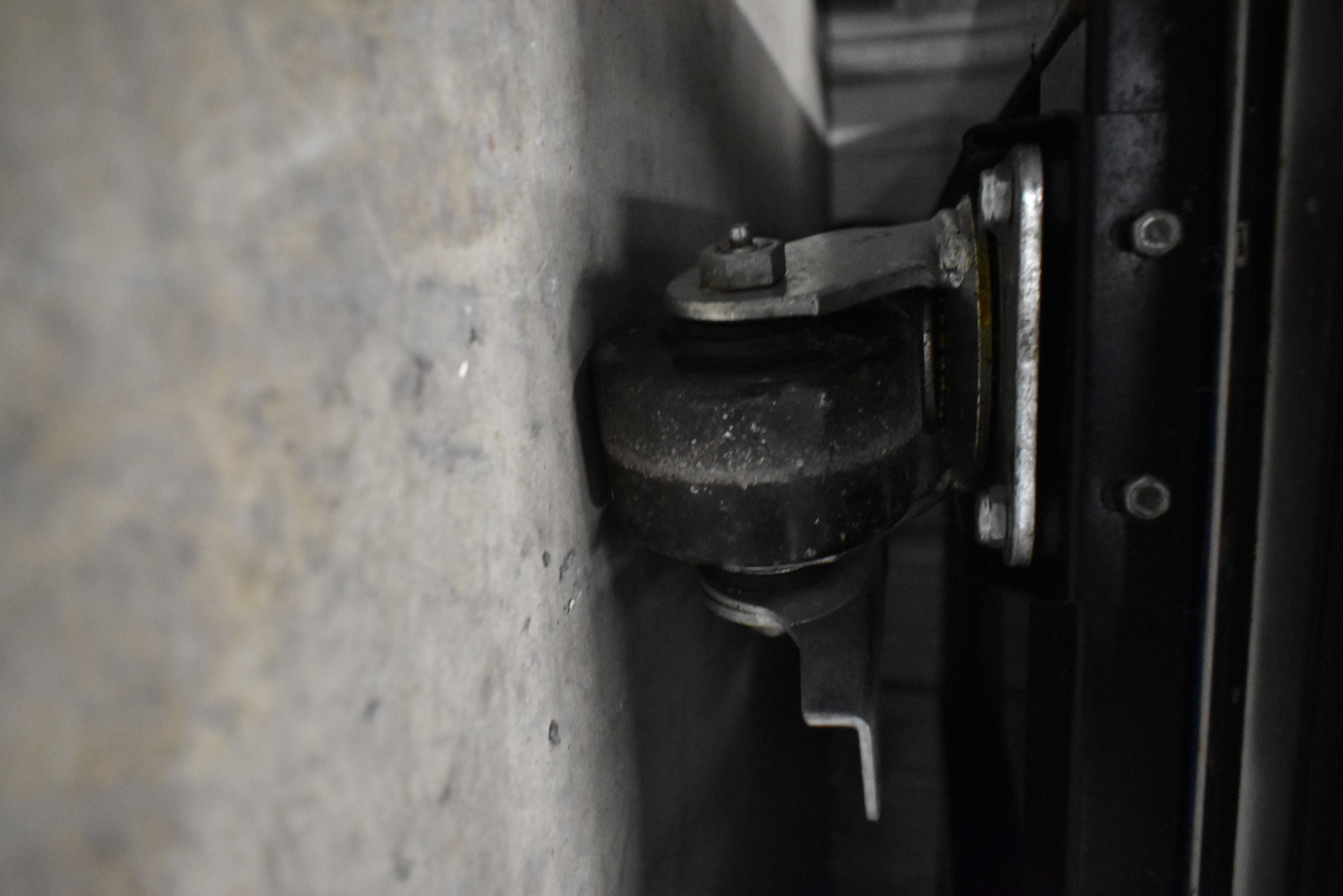
Commercial casters enable easy repositioning for cleaning and access
The plug-and-play nature makes reach-ins attractive for rapid deployment. Buy at auction one day, transport to your facility, plug in, verify temperature, load with product. No waiting for contractors, no infrastructure work, no complicated commissioning.
Maintenance Requirements
Commercial refrigeration is built to last and take a beating. Being mindful of maintenance extends already significant lifespan:
- Nightly cleaning: Wipe interior surfaces, check for spills, verify door closure
- Weekly fan cleaning: Clean condenser coils and fan. The harder the system works, the shorter the lifespan. Debris on coils forces longer run cycles and increased wear.
- Door gasket inspection: Check monthly for wear, tears, or compression. Replace when sealing integrity degrades.
- Temperature monitoring: Regular temping catches issues before they become inspection failures. Document readings as part of HACCP compliance.
The reality: the more the door opens and closes, the more debris accumulates on fans and coils, the more product stuffed inside, the harder the system works. Commercial units handle this abuse, but maintenance awareness extends service life and prevents surprise failures.
BNSD: The New Equipment Opportunity
Brand-new scratch-and-dent refrigeration delivers the latest equipment at substantial discounts. With 432 working BNSD units (21% of working inventory), the opportunity is consistent and substantial.
- BNSD Working Median: $700
- Used Working Median: $300
- New Retail 2-Door Cooler: $5,000-$6,000
- New Retail 2-Door Freezer: ~$7,000
- Savings vs New: 85-90% at auction pricing
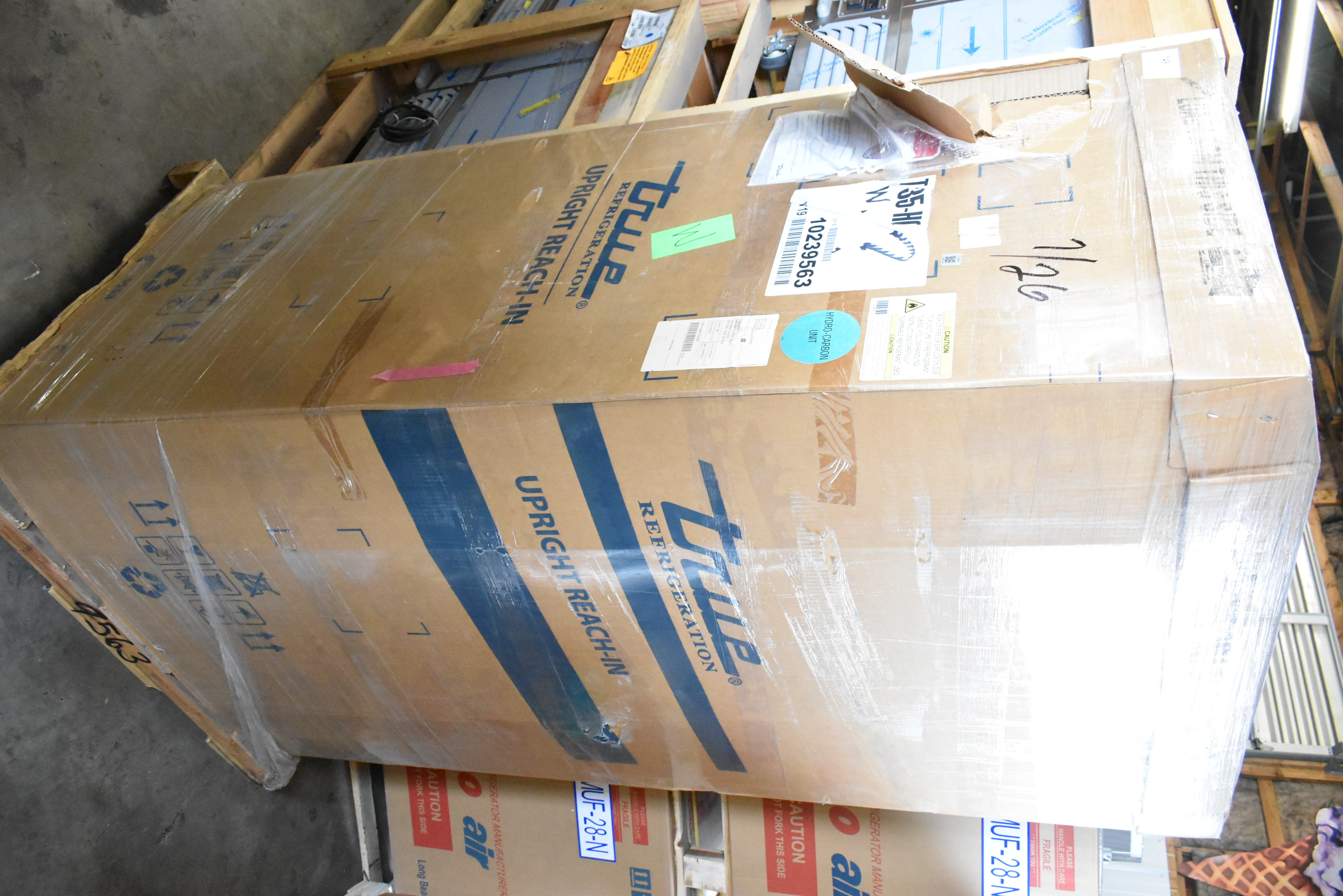
True T-35-HC brand new in original packaging—auction BNSD delivers manufacturer-fresh equipment at fraction of retail
BNSD units are cosmetically imperfect from shipping damage or warehouse handling. A dent in a side panel, scratched stainless surfaces, damaged packaging with perfect equipment inside—these scenarios create BNSD inventory flowing to auction. The refrigeration system is brand new. The functionality is complete. Only cosmetic appearance differs from retail showroom condition.
For back-of-house applications where aesthetics don't matter, BNSD delivers exceptional value. A $700 BNSD True 2-door cooler performs identically to the $5,500 retail version with a small dent you'll never notice behind the line. The math is compelling.
Immediate Availability Advantage
Ordering new refrigeration from manufacturers or distributors involves lead times—sometimes 4-8 weeks for popular models. BNSD units at auction are available immediately. Pick up the day after auction closes. For operations with failed equipment or opening on tight timelines, this immediate availability provides substantial value beyond price savings.
Bidding Strategy by Price Tier
The 3,114-unit database reveals clear price tiers with associated risk profiles and expected conditions. Understanding these tiers helps calibrate bids appropriately.
Under $100: Parts and Gambles
Units selling below $100 (8% of working sales reach this tier) are typically older models, minor brands, units with significant cosmetic issues, or working units where condition concerns suppress bidding. At this tier, you're either getting a bargain on functional equipment or buying parts inventory.
Non-working units dominate this price range with $51 median. For operators maintaining existing equipment, these parts-tier units provide economical access to compressors, condensers, shelving, doors, gaskets, and other components.
$100-$250: The Value Sweet Spot
This tier captures 26.8% of working sales—the volume sweet spot for budget-conscious operators. Single-door coolers, older 2-door units, and merchandisers populate this range. Equipment works, holds temperature, and meets food safety requirements. You're trading brand prestige and cosmetic perfection for substantial savings.
At $150-$200, working reach-in refrigeration costs less than a health department violation. The value proposition is straightforward: functional equipment maintaining food safety at accessible prices.
$250-$500: Quality Working Units
The largest tier at 28.7% of working sales. Quality 1-2 door units from major brands (True, Beverage-Air) populate this range. Equipment shows normal use but maintains full functionality. This tier represents the mainstream commercial kitchen standard—reliable equipment at reasonable pricing.
True T-23 and T-35 models commonly sell in this range. The industry-standard specification at 90%+ savings versus new retail.
$500-$750: Premium Used and Entry Freezers
This tier (15% of working sales) includes premium 2-door units, entry-level 3-door configurations, and freezers. The freezer premium (2.2X cooler pricing) pushes even basic freezers into this range. Equipment in this tier typically shows excellent condition with recent model years.
$750-$1,000: Three-Door Territory
Three-door units command $1,000 median pricing. At 8.6% of working sales, this tier serves operators needing high-capacity storage. Premium freezers also reach this range. Equipment quality is excellent—these prices attract competitive bidding only for genuinely desirable units.
$1,000-$2,000: BNSD and Premium
BNSD units dominate this tier (11.4% of working sales). True, Beverage-Air, and Traulsen BNSD inventory commands $1,000-$2,000 pricing for brand-new functionality. Premium used 3-door freezers also reach this range.
Over $2,000: Specialty and Premium BNSD
Only 1.6% of working sales exceed $2,000. Premium BNSD freezers, specialty configurations, and top-tier Traulsen units populate this tier. Buyers at this level are acquiring specific equipment to meet precise requirements.
The Bidding Reality
Working refrigeration at $300-$500 delivers 90%+ savings versus new retail pricing. For equipment that costs $5,000-$7,000 new, auction pricing is genuinely transformative. Don't overthink it—if a unit is "Tested and Working" from a major brand at $400, you're getting a proven performer at exceptional value.
The 67% working rate means roughly two-thirds of units we sell perform as expected. The remaining third splits between documented non-working units (parts tier) and unknowns. The transparency is real—you know what you're bidding on.
The Workaround Problem
More than any other equipment category, refrigeration shortfalls get "worked around" rather than addressed. These workarounds are symptoms of equipment needing replacement, not solutions to the underlying problem.
Common Workarounds We've Seen
- End-of-service transfers: Moving everything from reach-ins to the walk-in overnight because reach-ins don't hold temperature reliably. This practice isn't inherently bad—allowing reach-ins to circulate without obstruction reduces workload. But when it's mandatory because units can't maintain temperature with product inside, that's a replacement signal.
- Adding ice to reach-ins: Placing ice in the cabinet to supplement inadequate cooling. This creates moisture problems, accelerates compressor wear (fighting the added thermal mass of melting ice), and doesn't address the underlying failure.
- Running units colder: Setting thermostats lower to compensate for inadequate cooling. This may maintain acceptable temperatures but stresses compressors, increases energy costs, and doesn't fix the problem.
- Piercing valve refrigerant additions: As discussed, this is a short-term fix that doesn't address underlying leaks. The refrigerant will escape again.
The pattern: operators invest significant effort working around equipment problems rather than replacing equipment. The mentality is that replacement is prohibitively expensive. But auction pricing demolishes this assumption. A working 2-door reach-in at $425 is cheaper than months of workaround effort and the risk of inspection failure.
If you're currently working around refrigeration problems, stop. Calculate what you're spending in time, product loss, and risk. Compare to auction replacement cost. The replacement wins. And your operation becomes safer, more efficient, and inspection-ready.
Final Assessment: Affordable Food Safety
Commercial reach-in refrigeration at auction represents the most accessible path to food safety compliance available. With 2,086 working units sold annually at $310 median pricing, functional temperature-controlled storage is genuinely affordable for any operation.
- Working unit median: $310 vs $5,000-$7,000 new retail
- 67% tested working with documented temperature verification
- True dominance: 985 working units (47% of market) at $400 median
- Sweet spot pricing: 55.5% of working units sell between $100-$500
- Cooler median: $300 | Freezer median: $656
- BNSD opportunity: $700 median for brand-new equipment
The testing transparency sets refrigeration apart from other equipment categories. "Tested and Working" means verified temperature performance with documented readings. You're not gambling on functionality—you're buying confirmed performance at substantial discounts.
The food safety imperative makes this pricing even more compelling. The cost of failed refrigeration—discarded product, inspection violations, reputation damage, potential shutdown—dwarfs equipment replacement cost. A $400 working reach-in is insurance against catastrophic business loss.
Brand hierarchy provides clear guidance. True dominates for good reason—industry-standard construction, parts availability, service network coverage. Beverage-Air and Traulsen offer premium alternatives. Budget brands work for cost-constrained operations accepting trade-offs in longevity and serviceability.
Inspection intelligence prevents expensive mistakes. Avoid piercing valves. Verify evaporator fan operation. Check condenser coil condition. Inspect door gaskets. These visual checks supplement our electrical testing with additional confidence in equipment condition.
Installation simplicity—standard 115V power for most units—enables rapid deployment. No infrastructure work, no contractor scheduling, no extended commissioning. Buy, transport, plug in, verify, load product. Functional refrigeration in hours rather than weeks.
The workaround culture needs to end. If you're transferring product nightly because reach-ins don't hold temperature, adding ice to cabinets, or running units at maximum cold to compensate for inadequate cooling—stop working around the problem and solve it. Replacement costs less than the effort you're expending and the risk you're carrying.
Consider what's actually at stake. A health inspector finding your reach-in at 54 degrees triggers mandatory product discard, score impact, comprehensive inspection, and published record. One failure can damage a business irreparably. Preventive replacement with working auction equipment eliminates this risk at minimal cost.
The Delfield, the True, the Bev-Air—these brand names become generic kitchen shorthand because the equipment is everywhere, always running, always keeping food safe. At auction pricing, that ubiquitous reliability becomes accessible to every operation. Whether you need a single-door cooler at $299 or a 3-door freezer at $1,000, working commercial refrigeration is available at prices making food safety genuinely affordable.
Don't gamble with temperature control. Don't work around failing equipment. Don't risk your business for want of a refrigerator. Auction pricing makes compliance affordable. The 67% working rate provides buying confidence. The testing transparency eliminates functionality gambling. The value proposition is clear.
Replace your problems. Maintain your temperatures. Pass your inspections. Protect your business.
Ready to Bid on Commercial Restaurant Equipment?
PCI Auctions offers 600-900 lots weekly of restaurant and foodservice equipment including tested reach-in coolers and freezers, commercial cooking equipment, and complete restaurant liquidations. Preview in person at our Manheim, Pennsylvania facility, inspect equipment before bidding, and leverage auction pricing for your operation.
View Current Auctions